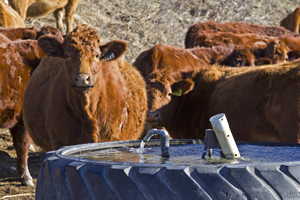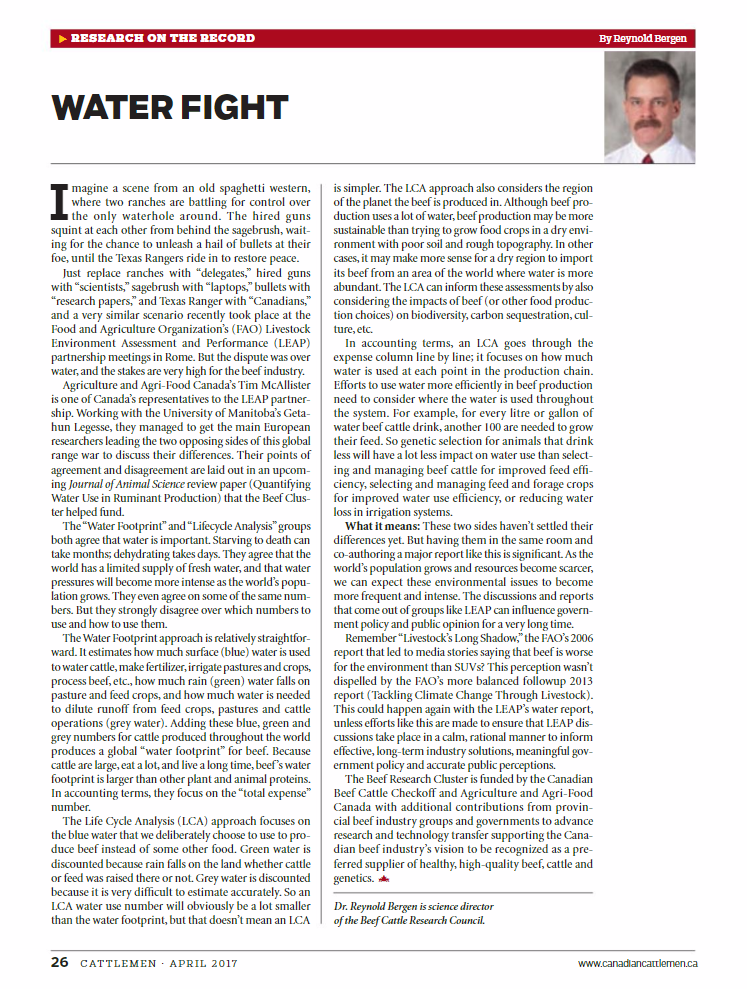Water Fight
This article written by Dr. Reynold Bergen, BCRC Science Director, originally appeared in the April 2017 issue of Canadian Cattlemen magazine and is reprinted on the BCRC Blog with permission of the publisher.

Imagine a scene from an old spaghetti western, where two ranches are battling for control over the only waterhole around. The hired guns squint at each other from behind the sagebrush, waiting for the chance to unleash a hail of bullets at their foe, until the Texas Rangers ride in to restore peace.
Just replace ranches with “delegates”, hired guns with “scientists”, sagebrush with “laptops”, bullets with “research papers”, and Texas Ranger with “Canadians”, and a very similar scenario recently took place at the Food and Agriculture Organization’s (FAO) Livestock Environment Assessment and Performance (LEAP) partnership meetings in Rome. But the dispute was over water, and the stakes are very high for the beef industry.
Agriculture and Agri-Food Canada’s Tim McAllister is one of Canada’s representatives to the LEAP partnership. Working with the University of Manitoba’s Getahun Legesse, they managed to get the main European researchers leading the two opposing sides of this global range war to discuss their differences. Their points of agreement and disagreement are laid out in an upcoming Journal of Animal Science review paper (Quantifying Water Use in Ruminant Production) that the Beef Cluster helped fund.
The “Water Footprint” and “Lifecycle Analysis” groups both agree that water is important. Starving to death can take months; dehydrating takes days. They agree that the world has a limited supply of fresh water, and that water pressures will become more intense as the world’s population grows. They even agree on some of the same numbers. But they strongly disagree over which numbers to use and how to use them.
The Water Footprint approach is relatively straightforward. It estimates how much surface (blue) water is used to water cattle, make fertilizer, irrigate pastures and crops, process beef, etc., how much rain (green) water falls on pasture and feed crops, and how much water is needed to dilute runoff from feed crops, pastures and cattle operations (grey water). Adding these blue, green and grey numbers for cattle produced throughout the world produces a global “water footprint” for beef. Because cattle are large, eat a lot, and live a long time, beef’s water footprint is larger than other plant and animal proteins. In accounting terms, they focus on the “total expense” number.
The Life Cycle Analysis (LCA) approach focuses on the blue water that we deliberately choose to use to produce beef instead of some other food. Green water is discounted because rain falls on the land whether cattle or feed was raised there or not. Grey water is discounted because it is very difficult to estimate accurately. So an LCA water use number will obviously be a lot smaller than the water footprint, but that doesn’t mean they’re any simpler. The LCA approach also considers the region of the planet the beef is produced in. Although beef production uses a lot of water, beef production may be more sustainable than trying to grow food crops in a dry environment with poor soil and rough topography. In other cases, it may make more sense for a dry region to import its beef from an area of the world where water is more abundant. The LCA can inform these assessments by also considering the impacts of beef (or other food production choices) on biodiversity, carbon sequestration, culture, etc.
In accounting terms, an LCA goes through the expense column line-by-line; it focuses on how much water is used at each point in the production chain. Efforts to use water more efficiently in beef production need to consider where the water is used throughout the system. For example, for every liter or gallon of water beef cattle drink, another 100 are needed to grow their feed. So genetic selection for animals that drink less will have a lot less impact on water use than selecting and managing beef cattle for improved feed efficiency, selecting and managing feed and forage crops for improved water use efficiency, or reducing water loss in irrigation systems.
What it Means:
These two sides haven’t settled their differences yet. But having them in the same room and co-authoring a major report like this is significant. As the world’s population grows and resources become scarcer, we can expect these environmental issues to become more frequent and intense. The discussions and reports that come out of groups like LEAP can influence government policy and public opinion for a very long time.
Remember “Livestock’s Long Shadow”, the FAO’s 2006 report that led to media stories saying that beef is worse for the environment than SUV’s? This perception wasn’t dispelled by the FAO’s 2013 follow-up report (Tackling Climate Change Through Livestock). This could happen again with the LEAP’s water report, unless efforts like this are made to ensure that the LEAP discussions take place in a calm, rational manner to inform effective, long-term industry solutions, meaningful government policy and accurate public perceptions.
Click here to subscribe to the BCRC Blog and receive email notifications when new content is posted.
The sharing or reprinting of BCRC Blog articles is typically welcome and encouraged, however this article requires permission of the original publisher.
We welcome your questions, comments and suggestions. Contact us directly or generate public discussion by posting your thoughts below.
